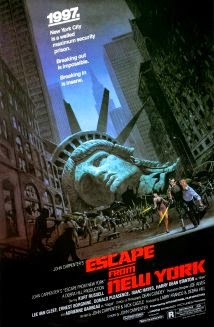
In John Carpenter's ancient 1981 film Escape from New York, convicted bank robber Snake Plissken (Kurt Russell) is sent into futuristic 1997 to rescue the US President from Manhattan, which by 1997 is a gigantic max-security prison. The film was called sci-fi, but today's gentrified Manhattan or San Francisco or Denver makes the film alternate history, a future not based in reality.
Two recent news and developments in Denver's gentrification made we wonder about my Northside neighborhood, which I and Bloguista Manuel Ramos have often written about, realistically, facetiously, or soberly, as Ramos wrote: "One of the regrettable things that has happened to Denver’s Northside, where I've lived for more than thirty years, is the rise and victory of the 'suburban aesthetic': boxy, boring housing lined up in rows; a uniform 'non-conformist' style from clothes to music; restaurants that are destinations rather than good places to grab a bite to eat; an obsession about 'making it,' a flaccid, common denominator cultural perspective. A great neighborhood has to be more than that."
 |
| A Highlands developer's dream |
Gentrification is defined as: "revitalizing neighborhoods, the movement of young, often single, professionals into low-income, heavily minority, neighborhoods near urban employment centers. Low-income and minority residents are pushed out by gentrification as the local culture and consumption patterns are taken over by upwardly mobile professionals."
Progress is defined as a gradual betterment; the process of improvingor developing something over a period of time; the act or process of growing or causing something to grow or become larger or more advanced."
Bolded words above took on different meanings as I sat on my front patio this week, wondering how gentrification had "revitalized, improved" or made the neighborhood "more advanced." It is "larger" in terms of population density, with condo and apartment complexes going up like Peyton Manning's touchdown-record.
Gazing down the street, from house to house, this is what I know. When people moved into these houses that were built in the 1940s, they were looking for homes to start families, places to raise their kids, within walking distance of neighborhood schools [3 within 5 blocks], and maybe not far from their jobs.
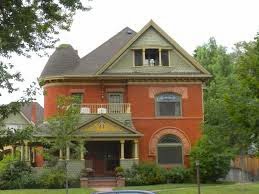 |
| A home the developers didn't raze |
In both of those two houses (imagine following my finger) live steelworkers, in that one a factory worker and his grocery clerk wife, in that one a retired railroad worker, in the corner one a postal worker, in that one lived a president of her union, and next door, a federal government worker, Until recently, I was a teacher. All of those people belonged/belong to unions--there's more I don't know about--which were part of the community culture. Finding a gentry-neighbor who's part of a union or who would support a union picket is as hard as finding cheap houses around here.
Next door to me lived a Chicano who I went to college with and was part of the Chicano student movement. Across the street, a woman who was one of its poets. The three of us, at least, had that in common. Student radicalism, Chicano pride, nonviolent protest. None of the gentry on my block come from such backgrounds.
 |
| A home, not an investment |
Across the street lived two girls who went to the Northside middle and high school with my two kids, one of whom lives five blocks away. Next door and two houses down, and in others sprinkled down the block, live/lived other kids who went to the same schools. They called themselves Northsiders, Vikings and attended North High School. Many stayed together at the same schools until they graduated or went on to college. With charter and split or hybrid schools all around us, the few gentry kids won't have neighborhood schools in common.
I can see the house where the Italian old lady [her son still lives there] use to drink on her porch. She was the same woman who would take care of neighborhood Mexican kids when their mother was late getting home. Or would feed Chicano children who she knew didn't have enough to eat when they got home from school. A steelworker from another house would regularly mow the two lawns of old ladies who couldn't push a mower or afford to pay anyone. A welder who lives over there and the guy who live there will weld something for you for free or run his snow-blower down other people's sidewalks. Another guy helped me with my fire-pit and another has fixed my car for me and neither would accept money. Of course, sometimes neighbors paid for work or bartered. I wonder whether today's gentry neighbors, with some exceptions, would act so neighborly for kids who might have lice in their hair, or let their gentry kids play with them, or even imagine that hungry neighborhood kids might be part of their responsibilities.
 |
| Really--you'd want to live in this? |
South of me lived a Chicano, then a Mexican family, then another Mexican family that had migrated without papers from the same region of Mexico. Next door to them, another family from that region. North of me lived a paperless Mexican family, and I can count five others on the block that are still homes to Mexicanos. Counting us, there's six Chicano families still around. Decades ago, I had no doubts about why my family moved here. Because there were Chicanos, working class, Mexicanos who spoke Spanish. Good decent-priced restaurants with a chorizo breakfast, or bars with affordable shots or a variety of tequilas, or clubs with live music and no cover and cheap beer, or Catholic church bazaars where you ate good, danced in the street and saw and talked with your raza neighbors. With the gentry here, most of that is disappearing. I know that in a lot of cases, the gentry see that as Progress.
 |
| Kurt can't save us from Highlands |
Our Chafee Park pocket of ranch house bungalows is zoned for families and no apartments. The developer-gentry may try to change that. (Over mi cuerpo muerto.) The old Northsiders moved here to find homes. Yes, they expected the house's value to rise, at least from inflation. But they moved here to stay, except for Mexicanos and Chicanos who got trapped by balloon payments, ARMs and under-qualifying loans. The four families I know about who lost homes had to move east to Aurora where ethnics can more afford to live or rent.
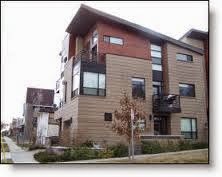 |
| Architecture: Highlands-ugly |
The developers have created another circle of Dante's Hell. Apartment buildings are going up, yes, like a Broncos' score. Monthly rents average $1,145. "Over 9,000 new apartments were built in 2013, 8,700 more are expected this year, and another 8,700 in 2015. 55,000 people will migrate here next year. "People are definitely looking at Colorado as the place to be. We have become an area where young professionals are moving. Entrepreneurs can start their businesses anywhere in the country, and so they are choosing areas where the lifestyle matches their preferences."
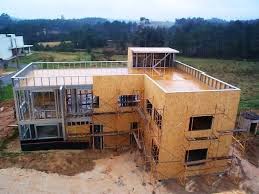 |
| You buy this, you breathe the chems |
I think of the new Northside--the developers renamed us Highlands, without our input--as Legoland. Like Ramos described above, apartment and condo boxes are slapped together with OSB instead of plywood like the old homes. It's 2/3 cheaper and the gentry will only see the outside. It doesn't matter that California wants to requirespecial warnings for these "chemicals known to cause cancer and birth defects or other reproductive harm, wood dust known to cause cancer." The median price for these boxes is $263,000. It's about money, investment, flipping houses and moving on. Not about neighbors and community.
This month in the Denver Post, Fine Arts Critic Ray Mark Rinaldi published "Did diversity miss the train in Union Station's architecture?" (The place is only ten minutes from my house.) The whole article is worth reading, but here's a sample:
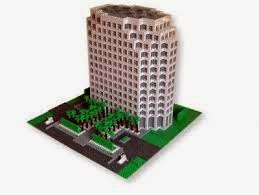 |
| Not Union Station; just big Lego |
"The urban playground at Union Station isn't drawing people of color and it may be the building's fault. Walking through the station, it doesn't look at all like Denver in 2014. More like Denver in 1950, Boise, Idaho, or Billings, Mont. If, that is, you are white and not paying attention. Or if you think diversity doesn't matter. If you do, you can't help but feel like something is off amidst all the clinking of martini glasses. If you are a tourist, you might get the idea that Denver doesn't have people of color. Or worse, you might think it's one of the most segregated cities in the U.S. That's not the case.
"The architecture's roots are in the glory days of France, England, Greece and Rome, empires that were nearly absent of ethnic minorities and who felt fully at ease invading, exploiting and actually enslaving the people of Africa, Asia and South America.
"Yes, that's all in the past; things have changed. But the $54 million renovation of Union Station doesn't take that into account. It restores the symbols of an old world with no updates. The gilded chandeliers have been rewired, the marble polished, but there's no nod to the present. Is Union Station Ready for the Next 100 years, as its marketing proclaims?"
Rinaldireceived over 316 comments. I won't't be surprised if the paper's conservative owners demoted or restricted him to articles about Bronco Stadium architecture. Here's a sample of the comments:
"So writing a racist article is OK if it is against white people?"
"White guilt is a large part of any college education now."
"We should just blow up all beautiful old buildings so that nobody is ever made uncomfortable by being reminded of what their ancestors didn't accomplish."
I don't know how many comments came from developers or gentry. But none of this sounds like the old Northside's neighborly ways of Italians, Chicanos, Mexicanos and others living next to each other. It certainly doesn't sound like tolerance.
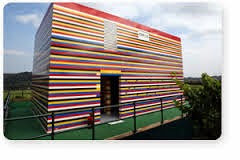 |
| Highlands next improvement? |
If you missed it, check Bobby Lefebre's La Bloga post from last week, Vanishing Chicano Culture and the Gentrification of Denver’s Northside. "He is the driving force behind the We Are North Denver movement that has shined a bright spotlight on the massive changes happening to the Northside - good and bad. When racist flyers recently appeared in the neighborhood, Bobby responded with action that focused on unity in the community. He wrote the following article originally for his website, which you can find at this link." Like Ramos said there, "As a resident of the Northside for more than thirty years, I agree with much of what Bobby says in this piece. Both Bobby and I would be interested in your reactions." 
 The Northside that's become the developers' and gentry's Highlands is a great candidate for a new Darwin Award for City Suicide. Already the signs of super-congestion, unflavored architecture and an unaffordable lifestyle and life have settled over my neighborhood like a new Brown Cloud. It didn't and doesn't have to be that way. Richer, whiter neighborhoods were inoculated from turning into Legoland. For instance, there's the Bonnie Brae Neighborhood Association whose zoning committee reviews all zoning requests. It's one of the most charming, coveted, million-dollar-homes areas in the West. Take note developers--of million-dollar-homes. Not made of cheap, toxic OSB or intended to look like Legos. And how about some solar?
The Northside that's become the developers' and gentry's Highlands is a great candidate for a new Darwin Award for City Suicide. Already the signs of super-congestion, unflavored architecture and an unaffordable lifestyle and life have settled over my neighborhood like a new Brown Cloud. It didn't and doesn't have to be that way. Richer, whiter neighborhoods were inoculated from turning into Legoland. For instance, there's the Bonnie Brae Neighborhood Association whose zoning committee reviews all zoning requests. It's one of the most charming, coveted, million-dollar-homes areas in the West. Take note developers--of million-dollar-homes. Not made of cheap, toxic OSB or intended to look like Legos. And how about some solar?
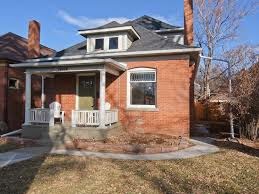 |
| Old Northside home, family-friendly |
Except for the Lefebre and Rinaldi articles, I don't know why I wrote this. I'm not lamenting so much as remembering. Why we came here. What here is. And was. What it shouldn't become. What it shouldn't lose. Its ethnicity. Its multi-national neighborhood quality. Its sense of community. It's the Northside.
Es todo, hoy,
RudyG, a.k.a. a Northside who's not quitting. Or moving.
by RudyG
gentry - the qualities appropriate to a person of gentle birth; upper or ruling class.
gentrification - the process of renewal and rebuilding accompanying the influx of middle class or affluent people into deteriorating areas that often replaces earlier usually poorer residents. [definitions: Webster's Dictionary]
So, some gentry "of gentle birth" are renewing, rebuilding and replacing all over your barrio. Should you let the coraje get to you and start making bilingual picket signs and petitions?
One common belief is--Simón, ese! The price of local pizza will go up, tamales-by-the-dozen will become rarer than a Chicano jogger, your favorite cantina will be remodeled into a vegiburger or starbucked bistro where one item can cost more than a dozen tamales, and your neighborhood school will be turned into a more exclusive charter factory that features maybe a dozen chicanitos. But that's such a shortsighted, narrow and "poorer" view, it might be better to take a longer, broader and "richer" perspective on the phenomena.
Based on decades of scattered, sometimes sober, observations of Northside Denver's gentrification, as well as hundreds of hours drinking Negras on Friday afternoons out in my front yard with my untrained perro Manchas, I've discovered undiscovered value to these invasions. It's not all floating caca under the bridge, but our "usually poorer residents" can benefit from this "influx of middle class or affluent people" and even climb the economic-advantage ladder to almost becoming "upper or ruling class." Here's how I see it:
Signs when a barrio gets gentrified | Benefits for barrio gente |
1. When the forecast calls for "surf's up" on the beach or mountain snow, gentry's trash & recycle bins hit the curbside days before scheduled pick-up, encouraging burglaries. | Since gentry obviously aren't home, this gives you time to search their bins for aluminum cans and junk to sell at your biannual yard sale, if you simultaneously watch your casa. |
2. Yards that never had gardens are suddenly filled with lush plants, tall green trees and expert landscaping, making yours look like a monte with a barber-college haircut. | You won't have to nag your esposa to cut the lawn or weed the garden anymore because there's no way yours can ever look as suave or verde as theirs. |
3. On the other hand, that deceased viejita's rosebeds are pulled up and replaced by formulaic gentry-landscapes that produce a few small flowers with little maintenance. | Your d-i-y landscaping is the most unique around, and scrawny roses you transplanted when everybody was at the viejita's funeral make gentry think you got a green thumb. |
4. Newspapers on gentry's front yards pile up because they all have wireless IPods & IPads and don't read print--or went skiing--but have too much disposable income and don't cancel their subscriptions. | You don't waste money anymore on subscriptions; you just take your dog on his customary, new, morning walk, nonchalantly pick up your free copy and your esposa compliments you for getting up off your fat nalgas. |
5. The viejitos who struggled along with their walkers don't come by anymore to help improve your pocho Spanish, and the young, fit güera/güero joggers never stop, unless they need a translator. | Young, fit, güeras (or güeros, if that's how you jog), jogging--paint your own picture and also see #6. |
6. New, monolingual neighbors have replaced the fluent Spanish-speakers who stopped by on Fridays to chat and help you improve your pocho bilingualism, so now you always converse in English-only. | Your status rises when your pocho Spanish makes you El Primo Translator of the block, and you now translate for landscaping, drywall and roofing vatos redoing the barrio, and they envy your English fluency. |
7. Your neighbors' pure-breds are fully trained, bark less and live inside more than your mongrel, targeting you for nuisance-dog complaints. | When robbers check out your block, they stay away from your casita and its unsocialized, barking mongrel, making you look smart to la esposa. |
8. New, shining, MPG & GPS-equipped silver cars sit in gentry driveways, increasing local car thefts and making your old troca look like it belongs to one of the roofers. | There's more neighbors with working cars who you can ask to boost your worthless troca's battery on sub-zero mornings, if they're not skiing. Plus, see #7 above. |
9. Gentry breweries and cafes have replaced your dive bars and cheap taco joints, forcing you to drive miles on Fridays for tus traguitos and some refritos con green chile picoso. | You save chingos by buying six-packs and bags of chicharrones, while spending more time training your mongrel out in your front yard, waiting for translation requests and Benefit #5. |
Of course, this list is incomplete and La Bloga readers are encouraged to add to it. There could be thousands and thousands of ways for our "usually poorer residents" to benefit from the "upper or ruling class" takeovers of their neighborhoods. Qué no, gente?
Es todo, hoy,
por RudyG
'Cause that's what we do around here.
* In the New York Times, an interesting article on how small-scale and niche manufacturing in Brooklyn is prospering even as larger concerns suffer in the economic downturn:
Many business owners interviewed said they were staying strong in this market by employing few workers and keeping their products specialized. “They tend to be very nimble, even in the downtimes,” said Mr. Kimball. “They can make it through a difficult stretch easier than the bigger players.”
Manufacturing isn't retail, but I can't be the only one to see a parallel to the indie store which can make adjustments and cater to local clients as corporate sellers can't. We ARE all making those adjustments, right?...
* Also in the
Times, an article that evokes the great urbanist Jane Jacobs in discussing how internet forums and social networking, especially in New York City neighborhoods,
can strengthen local bonds, not increase isolation:
The Web was first seen as a radical alternative to the bricks-and-mortar world, but the truth, it turns out, can be more complicated.
“The original idea of the Internet was to get away from physical geography,” Steven Johnson, a 40-year-old Brooklynite and the author of several tech-related books, said as he sat in the Dumbo loft that serves as the office to Outside.in, a Web site he helped to found two years ago. “The dream was that everybody would be able to telecommute from Wyoming.”
Yet, the Internet has also had the opposite effect by helping to connect people more closely to their physical and political surroundings. And for New Yorkers, whose surroundings are more complex than most, this effect can be particularly powerful, enabling them to take on the long-anonymous, too-big-to-fight city.
There's also an acknowledgement of the gentrification wars that seem to flare up on every neighborhood blog (whose side are
you on?!?) -- but this is a good way to think about how a local bookstore can be a part of their online neighborhood as well as their physical one.
* Sometimes, it takes a Nobel-prize winning author to stem the spread of panic and illogic in a publishing corporation. Thanks to a letter from Gunter Grass, Umberto Eco, Amos Oz, Wislawa Szymborska, Jose Saramago and others, beloved and competent editor Drenka Willen
has been re-hired at Houghton Mifflin Harcourt, after being fired last month. Score one for literature over the suits. (Thanks to
Levi for
the link.)
* I'm still thinking about the question inherent in Jason Lutes'
Berlin graphic novels about how and whether artists and writers should be engaged with politics. Pankaj Mishra
has one answer: if writers are there in the shit and they write about it, listen to them. Arundhati Roy and David Grossman are certainly examples of writers whose political ideas and expressions we would be mistaken to ignore.
* The good news about the following kerfuffle is that the backlash happened so fast. To quote Sarah Retger at the ABA Omnibus:
Harvard Business School professor Anita Elberse wrote a stunningly dumb article for the WSJ in which she argued that the only way for publishers to survive is by throwing lots of advance money at projects they hope will be bestsellers. Happily, people more eloquent than me have done the necessary debunking, criticizing, and introducing of logic.
My own two cents: there's nothing wrong with hoping for a blockbuster. But shelling out multi-million dollar advances (at the expense of publicity efforts for the rest of the list) ain't gonna get you one. One of the strengths of books as a medium is that they're viable on such a small scale; we're lucky for the books with print runs of 500 as well as those with 50,000, and it would be great to see publishers begin to think critically about how to work those strengths for a diverse, vibrant, long-lived list.
* Ooh, here's a nice one: the National Endowment for the Arts survey, usually a staple of doom and gloom about the state of American literacy, this year shows
a substantial increase in the numbers and percentages of readers. I have yet to read through the complete findings, and it will be interesting to hear theories on why the shift occurred, but it does strike a bright note.
* This kind of counts as good news:
I'll be speaking at the Brooklyn Business Library's PowerUp! awards ceremony on Wednesday night, in my capacity as past winner. An interesting opportunity to review the past year in the bookstore process. Free eats, also.
What have YOU got going on that's good?
















This comment has been removed by the author.
And here is is without the typo: Where I live we have a barrio with pretty gardens and shrines to the Virgen de Guadalupe a few blocks from a house with fake guard tower complete with a rifle-totting mannequin and an YOU CAN TAKE MY GUN WHEN YOU PREY IT FROM MY COLD, DEAD FINGERS sign. The gentry seem to afraid to come here, but the African immigrants like it. ¡Viva Arizona!
My childhood neighborhood was puro fenced-in dirt, except for the Benta's next door. They had the only manicured lawn for blocks around. Of course, our dogs preferred to poop there causing endless friction between them and my grandpa, who lived up front. Our house was in the back of the lot. He sat on his front porch every day in warm weather, smoking a pipe and talking to his parrot, but the problems with the Benta's continued. He ended up creating a barrier of found wood and metal between his yard and theirs so he wouldn't have to see them when they pulled into their driveway. Theirs was the only attempt at gentrification I remember. I hope they remember him and our dogs fondly.
Rudy, this certainly brings back memories of my own dusty, poor neighborhood when I was growing up in South Texas in a little town of 20K people. Few folks had grass in their yards, with no professional landscaping, no hired gardeners, lots of dust swirling on windy days (which was frequent), and a caliche street, with huge chunks of gravel. I was pretty grown by the time our street finally got paved in asphalt. The neighborhood now, more than 40 years later, still looks pretty much the same. Thanks for your good sense of humor!